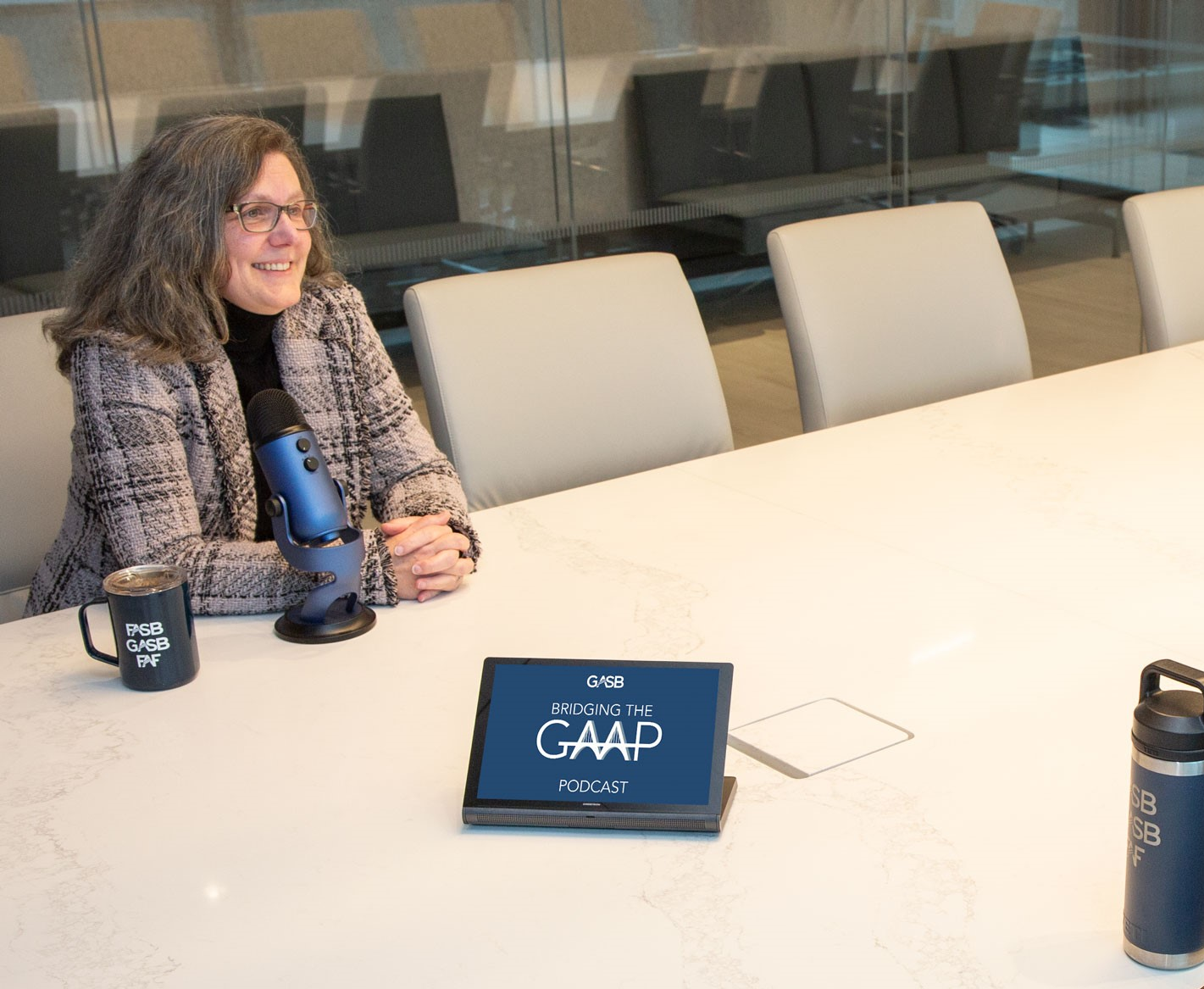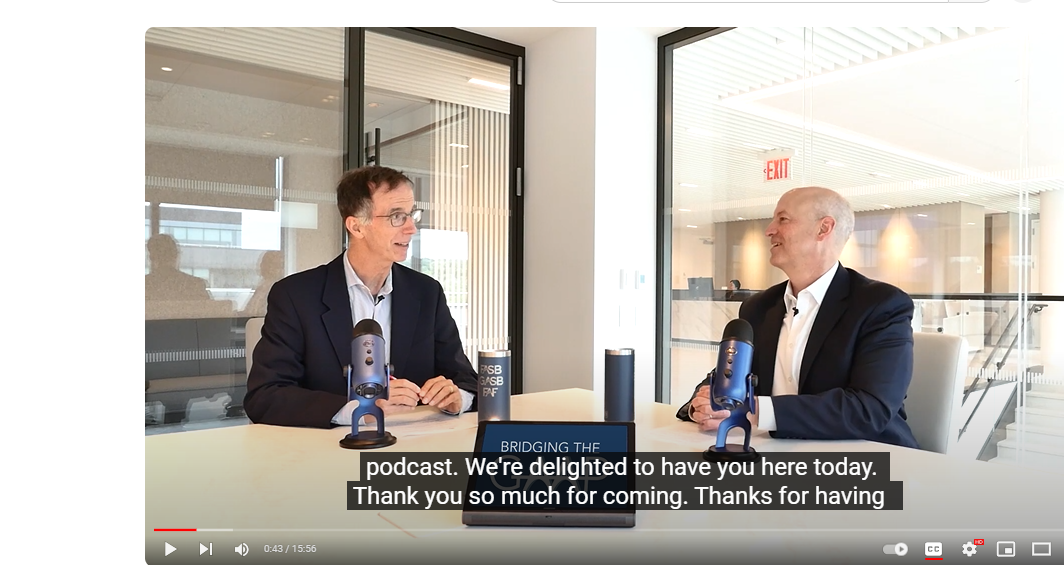Episode Transcript
Eileen Foley [00:00:07]: Hi everyone. Welcome to Bridging the GAAP, a podcast brought to you by the Governmental Accounting Standards Board, with our host, Matt Broder, Vice President of Communications at the Financial Accounting Foundation. I'm Eileen Foley, Senior Manager of Digital Operations, and I'm excited to be here with GASB Chair Joel Black for the second part of our series, introducing GASB's Post Implementation Review process. Joel, welcome.
Joel Black [00:00:32]: Thanks, Eileen. It's always great to be here with you, and we're very excited for this second episode in our two-part series on the Post Implementation Review process, or PIR. The first episode was about the process overall. This episode, we’ll get into the results of one of our reviews.
Eileen Foley [00:00:50]: So, Joel, what did that review actually cover, and do you mind sharing with us a little bit more about who Matt will be speaking with today as well?
Joel Black [00:00:57]: Sure. That review covered our pension standards, which include GASB Statement No. 67 and 68. Matt will be talking to Tammy Waymire, who is a Senior Research Manager at the GASB and was very involved in the pension PIR.
Eileen Foley [00:01:13]: That's awesome. I look forward to hearing more about that. All right, then let's go ahead and listen in as Matt welcomes Tammy to today's episode.
Matt Broder [00:01:21]: Thank you so much, Joel and Eileen. Welcome, Tammy, to Bridging the GAAP. We are going to start today, I think, just by reminding our listeners about GASB's original pension project. What was it, when did it take effect, and what new information did that pronouncement provide to financial statement users?
Tammy Waymire [00:01:44]: Thank you, Matt. It's a pleasure to be here with you today and talk about the culmination of this pension Post Implementation Review, or PIR, report that the staff just recently completed. And probably a good idea for the listeners to start with the background of the pension project. That project, as many of our listeners likely remember, included some of the basic provisions but came along in 2008, when it was added to the Board's project or technical agenda at that time. It resulted in two statements by 2012: Statement No. 67 and Statement No. 68. Statement 67 addressed the accounting and financial reporting for public pension plans, and Statement 68 addressed the accounting and financial reporting for government employers. What most people will probably remember is that those statements resulted in the recognition of the net pension liability directly on the face of the financial statements where it had previously been disclosed. So, it was somewhat of an elevation of that content from the notes to the face of the financial statements. It also involved some changes in the measurement of how that liability was calculated. So, there were provisions around the discount rate and additional provisions related to required supplementary information, giving users more context for the newly recognized net pension liability. It all followed the issuance of two concept statements, Concept Statements 3 and 4, that addressed communication methods and elements of financial statements. So, it was a time to refresh the existing pension standards, and those two statements spanned every aspect of financial reporting.
Matt Broder [00:03:26]: Yeah, so what I'm picking up from what you just said is that, first of all, this has a very long history, going all the way back to 2008. That was 16 years ago. And I guess the other thing I'm picking up is that what the GASB really did was elevate the level of transparency around these pension liabilities that states and cities have around the country.
Tammy Waymire [00:03:49]: That's right. And I think just by placing those liabilities directly on the face of the financial statements—and I know we'll get to this—but that was one of the benefits that users perceived with that change.
Matt Broder [00:03:59]: And so, that's obviously a big step forward for transparency and for users of government financial statements. When your colleague Alan Skelton was on our show in our last episode—Alan, of course, is the Director of Research and Technical Activities at the GASB—he shared with listeners what the three basic objectives are of a Post Implementation Review, or PIR. As you said, maybe just take a minute, if you would, to refresh our memories on what those objectives are when you start a PIR project.
Tammy Waymire [00:04:33]: Sure, glad to do that. The three basic objectives are: first, to determine whether the standards are meeting their stated purpose. There are five sub-objectives that go along with that main objective. The second objective is to evaluate the cost of implementing the standard, including the ongoing application of the standards, as well as the benefits that users get from that information. And then the third and final objective is to evaluate whether the PIR team finds any recommendations for improvements to the standard-setting process, and those would be communicated in the report. Within that first objective, breaking it down further, the components include whether the standards resolved an underlying need for the financial information being reported, whether the information provided is decision-useful, and whether the statements are operational. Given the comprehensive nature of the pension standards, there's a lot to evaluate there. The fourth and fifth sub-objectives are associated with whether there were any unexpected changes to operations or financial reporting, or any unintended consequences. It's important to note that when we get to the second objective and think about costs and benefits, we're measuring those relative to what the Board contemplated at the time—that’s our reference point. As for the third objective, it’s key to understand that we’re not necessarily recommending changes to the standards but potentially suggesting changes to the standard-setting process.
Matt Broder [00:06:18]: I see. So, these are pretty foundational questions. From a practical standpoint, how do you actually go about answering these questions? Do you conduct surveys, meet with stakeholders? These are big questions, so how do you gather the information needed to answer them?
Tammy Waymire [00:06:37]: That's a good question, and I think you could ask us, "Do you do the following outreach activity?" and fill in the blank with almost anything, and we would say, yes. We have a wide range of activities in a Post Implementation Review, particularly in what Alan described in the first podcast about Stage Two, which is the post-effective date evaluation of costs and benefits. During that stage, we primarily draw on four main methods for evaluating the standards. These include roundtables where stakeholders—preparers, auditors, and users, as well as pension plan representatives, actuaries, and benefits consultants—can discuss their experiences with the standards, whether from a user or preparer perspective. Unfortunately, these roundtables had to be virtual due to COVID, but it was a valuable experience nonetheless. We also conducted a variety of surveys, including cost surveys with preparers who provided information on what it cost them to implement the standards. These surveys were conducted with all five groups mentioned earlier. Additionally, we collected archival data—extracting information from financial reports to evaluate whether we’re seeing what we expected based on the standards. While archival data has its limits, it gives us a sense of whether governments are able to operationalize the standards. Finally, we engaged with the academic community, synthesizing academic literature to evaluate whether there were any unintended consequences or costs associated with the implementation. In the case of the pension PIR, we even awarded a research grant to study trends in discount rates. It’s important to note that the PIR team was independent of the original project, which helps ensure objectivity in the process.
Matt Broder [00:09:32]: Oh, that’s interesting.
Tammy Waymire [00:09:33]: Yes, we try to insert some objectivity into the process. It doesn’t mean we don’t use subject matter experts, but we make sure that those leading the effort, like Joanne Su, were independent of the original project. This helps ensure independence in the PIR process.
Matt Broder [00:09:55]: Yes, and I know that GASB has another quality control method, your technical inquiry service. This service allows those implementing a standard, who might run into a challenge or question, to reach out to GASB for guidance. Do you use this information as well in the PIR?
Tammy Waymire [00:10:20]: We do, absolutely. I’m glad you asked that question. The technical inquiry service is available for any standards we issue, and for major standards like pensions, which have a formal PIR—what I like to call an "uppercase" Post Implementation Review—we use these technical inquiries to gauge how well preparers are able to implement the standards. Most of the inquiries come from preparers and auditors, though users can also submit questions. In the pension PIR report, we trended these inquiries over time, from before implementation through to after implementation. We saw what you might expect—a spike in inquiries during the implementation period, followed by a decline. This suggests that preparers and auditors were learning and that our educational outreach and the issuance of implementation guides were helpful. This trend supports our conclusion that the standards were operational.
Matt Broder [00:11:41]: Right, right. So, with all this information gathered in the PIR process, what did you ultimately learn about the standard—how well it’s being used, adopted, and implemented?
Tammy Waymire [00:11:55]: That’s a great question. I think about where I was in 2008 when the project was put on the Board’s agenda—I was just finishing my PhD, starting my first academic appointment at Northern Illinois University, and teaching governmental accounting. For me personally, I would have followed the standard from the invitation to comment on the preliminary views, through to the exposure draft and the final standards. But I was primarily focused on how to teach it, from a 30,000-foot view. Working on the PIR was a great learning experience, diving into the technical aspects of the standards and the implementation process at GASB. For the PIR team, since none of us were part of the original project, it was a significant learning experience. We compared the feedback from outreach with what the Board had contemplated in the basis for conclusions to determine whether the results aligned with expectations. Overall, we found consistency—during the four years of due process from 2008 to 2012, the Board had identified and addressed the major issues, and there were no significant blind spots in the conclusions reached.
Matt Broder [00:13:38]: So, to stay at that 30,000-foot level, what did the GASB ultimately determine about the pension standard? Did it achieve its original purpose? Did it solve the problems it was designed to address?
Tammy Waymire [00:13:55]: Yes, absolutely. The short answer is yes. If we go back to the three objectives at the outset, the standards met their stated purpose. The costs and benefits were as the Board contemplated and consistent with what stakeholders expected at the time. The costs were significant, as expected, but the benefits were also significant, justifying the changes. While there are still disagreements among stakeholders—particularly around issues like the discount rate—these were anticipated by the Board, and no changes to the standards would have resolved all disagreements. The goal was never to make everyone happy but to provide a fair and transparent standard.
Matt Broder [00:15:08]: So, what comes next? The Post Implementation Review is complete. For a major standard like this, is there a post-Post Implementation Review, or is this now settled, with future changes or improvements happening in the normal course of GASB's business?
Tammy Waymire [00:15:31]: That’s a great question, and I think many listeners probably wonder about that. For the PIR team—myself, Jaylan, Danielle Pollack, and the numerous postgraduate technical assistants who helped with this project—it was a finite project. The PIR is complete; the report has been presented to the Board and the Trustees, and all the information, including where disagreements still exist, is documented in that report. We didn’t have any recommendations for changes to the standards themselves or the standard-setting process. There’s always room for continued improvement, and we’ll apply what we’ve learned to future PIR projects. But as for the pension standards, the review is complete. Any future projects related to pensions would be up to the Board to add to the technical agenda, but there are no plans for that at this time.
Matt Broder [00:16:31]: Understood. Great. Thank you. Well, Tammy, thank you so much for joining us today and helping us all better understand this important topic in GASB Land. Thank you so much.
Tammy Waymire [00:16:42]: Thanks, Matt. I appreciate it.


